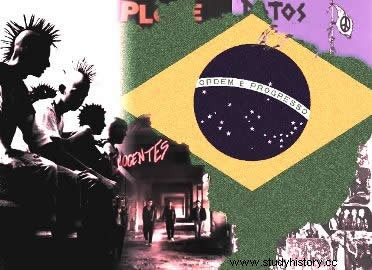
Contestation, attitude, acid lyrics and few chords. In a very simple way, these would be the basic elements of a socio-musical movement that won the Brazilian music scene in the late 1970s. The so-called punk rock, fundamental carrier of the so-called punk movement, reflects specific cultural and historical phenomena that reveal questions political, economic and social quite interesting in Brazil at that time.
Despite its foreign origin, punk music and ideology had great power of dialogue with the youth that breathed the last airs of our military dictatorship. Abroad, young English and North American suburbanites sought to break out of the doldrums and subjectivism of the hippie and progressive rock movement to speak directly and objectively about their anxieties, anxieties and political positioning.
The sung English nonconformism soon gained ground in São Paulo among students and young people employed in low-paid jobs. The lack of employment and the surveillance of the authorities were the main bases for the youth of the poorest neighborhoods in São Paulo to use aggressiveness as an escape valve and artistic creation. Already in this period, bands like Restos de Nada and AI-5 (a clear mention against the still in force military regime) were born.
However, the prominence of the movement also seems to have reached other parts of the country, causing the appearance of punks in other urban centers. Under the government's beard, Aborto Elétrico (formed by future members of the Legião Urbana and Capital Inicial) and Plebe Rude disseminated the punk aesthetic in the music scene in Brasilia. In Bahia, the Camisa de Vênus group was responsible for creating some of the hymns that marked this movement.
One of the great milestones of this movement took place in 1982, when some punk rock supporters organized the festival “The Beginning of the End of the World”. In this great moment of mobilization of Brazilian punks we had the participation of bands of great representation such as Inocentes, Cólera and Ratos de Porão. In fact, this event represented the do-it-yourself attitude that prompted the independent organization of graphic material, concerts, festivals and the recording of some songs.
With the passage of time, and the explosion of bands with greater commercial appeal (such as Titãs, Paralamas do Sucesso, Legião Urbana, Ira!, Kid Abelha and Ultraje a Rigor), the punks' angry posture ended up not having repercussions among the general public. . In this way, Brazilian punk began to survive in a borderline way in the creation of an underground scene of national youth music.
However, the aesthetic contribution of that moment still reflects in the formation of other bands and musical genres in Brazil. The irony, the direct contestation of everyday issues and the sound impact are some of the legacies that can be seen at this moment. Anyway, Brazilian punk should be seen as a style that demonstrated to us with few resources the will of young people interested in ending the years of repression that marked the country.
